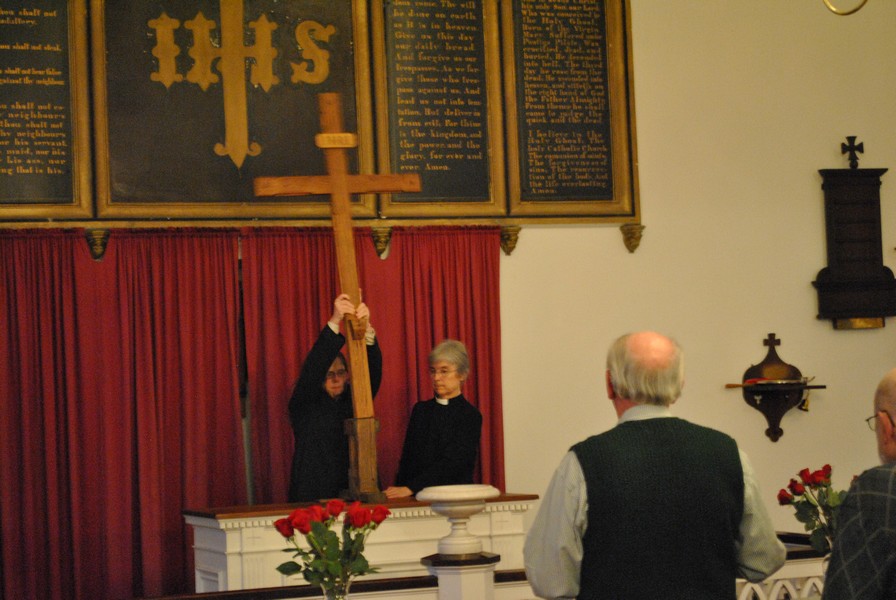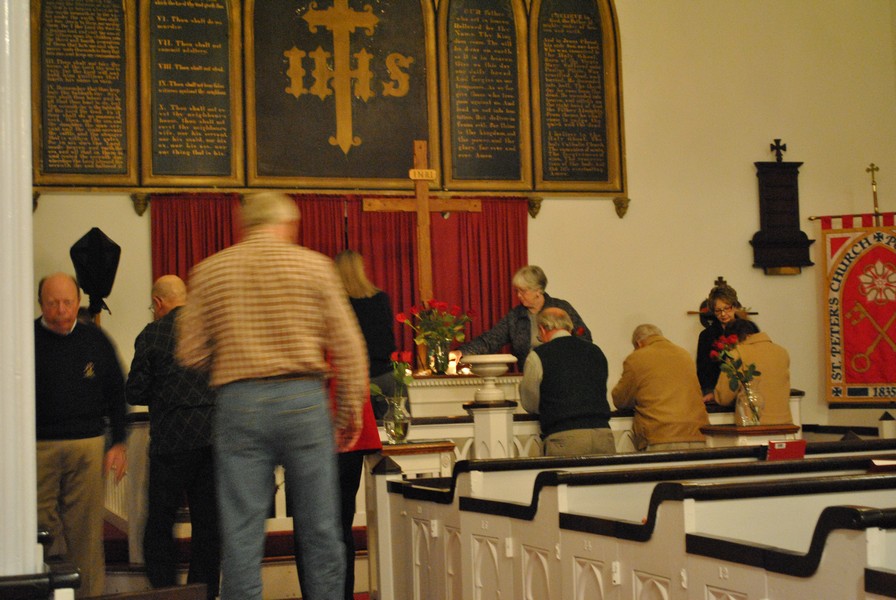
Good Friday is a blend of all of the Holy Week services. There is a long reading like Palm Sunday, this year in Luke. The reading in Good Friday is always from John, a very detailed account of Christ’s last day
Like Tenebrae, Good Friday creates a mood and like Maundy Thursday is one day, the last one for Christ. It maybe is the most emotional one – from disbelief over the arrest, flogging, trial and eventual crucifixion in a quickly moving Friday to one of horror, anger and reflection. Horror and anger that a Jewish man was condemned by Jewish officials to one of the worse means of death. Reflection is that you realize he told you all of the time this would happen. Reflection – what does it mean today ?
John’s gospel more than the others witnesses to the victory of the cross. John juxtaposes the persecution of the day with the idea that in the end Jesus is in control, revealing the glory of God.
At St. Peter’s we sit for the first part of the Gospel and then rise as a congregation for the last part and the drama intensifies
The sermon took the first part of Psalm 22 – “My God, my God, why have you forsaken me? Why are you so far from saving me, from the words of my groaning? O my God, I cry by day, but you do not answer, and by night, but I find no rest.” It was the third time it had been said this week, but the intensity now was far greater. The sermon moved quickly to the present with many examples of feeling of forsakenness in the modern world. The glory of Good Friday diminished.
The Solemn collects, the entrance of the cross, the anthems and finally the reproaches followed in succession.

The inri cross made by Helmut (thanks many times over) is brought in to the barren altar and raised admirably by Kimberly. The letters “INRI” are initials for the Latin title that Pontius Pilate had written over the head of Jesus Christ on the cross (John 19:19). The acronym INRI (Iēsus Nazarēnus, Rēx Iūdaeōrum) represents the Latin inscription which in English reads as "Jesus the Nazarene, King of the Jews" and John 19:20 states that this was written in three languages: Hebrew, Latin and Greek during the crucifixion of Jesus.
The reproaches focus on God’s gifts to man over the Bible and man’s unfortunate responses. God answers through the reproaches said afterwards.
God responds taking selected verses from the reproaches
“What have I done to you, or in what have I offended you?
I led you forth from the land of Egypt,
And delivered you by the waters of Baptism,
I led you through the desert for forty years,
And fed you with manna I planted you, my chosen and fairest vineyard,
I made you the branches of my vine I scourged your enemies and brought you To a land of freedom
I gave you a royal scepter
And bestowed the keys to the kingdom,
My peace I gave, which the world cannot give,
And washed your feet as a sign of my love,
I sent the spirit of truth to guide you,
I grafted you into the tree of my chosen Israel, I came to you as the least of your brothers and sisters;”
So what have we done?
“But you have prepared a cross for your Saviour
But when I was thirsty, you gave me vinegar to drink,
And pierced with a spear the side of your Saviour
But you have scourged, mocked and beaten me
But you have given me gall and left me to thirst.
But you have given me a crown of thorns
But you have hanged me on the cross.
But you draw the sword to strike in my name
But you scatter and deny and abandon me.
But you continue to quarrel and divide.
But you cast lots for my clothing.
But you made them scapegoats for your own guilt.
But you have prepared a cross for your Saviour.”

We now become active participants exulting God and his creation and providing a better response. We took a rose from the container and laid them at the foot of the cross. We wrote private prayers ; We prayed at the altar. We left in silence – the final reflection. We move from spectators at the beginning of the service to those who are actively taking a part having been brought into this dramatic service.
The bulletin cover with ashes in the shape of a cross was the same one used in Ash Wednesday at the beginning of Lent. Lent has come full circle. Then it was us witnessing to our own mortality; today it represented Christ’s and the ashes are in the shape of a cross
